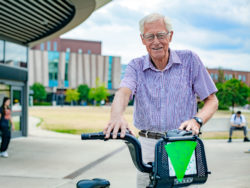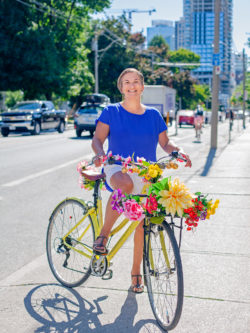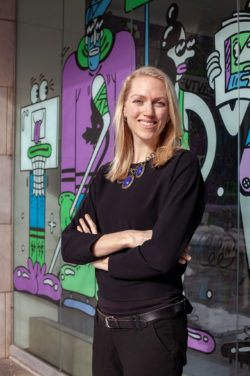Cycling in the City
by John Lorinc
photography by Sofie Kirk
In the first five years of John Tory’s (LLB Osgoode ’78) mayoralty, the City of Toronto’s record on adding cycling infrastructure was unexceptional – an improvement from his immediate predecessor, Rob Ford, who saw bike lanes as part of the “war on the car,” but well behind the pace set by David Miller (Honorary LLD ’22) during his seven years as mayor.
And then the pandemic happened. Since 2020, the City has laid down 47 kilometres of new bike lanes, by far the largest expansion since amalgamation in 1998; the network includes partially or fully protected lanes on Bloor, Danforth, Yonge and University. Council, says Ry Shissler (BA Film Studies ’08), a Toronto cycling advocate who recently served as the communications manager at CycleTO, saw it as an important file, and municipal officials were reassigned to focus on building out the network.
Shissler’s concern, however, is whether that sense of urgency is flagging as more people return to their offices and traffic congestion builds. “We’re seeing a lot of hesitancy from political leadership to push these things forward,” they say. The parts of the city outside the core are a particular concern.

During their degree, Shissler lived in the Jane and Finch area and rode to the Keele campus. “I had to use Finch Avenue to get there, and I did that exactly one time on the road, because it was terrifying,” they say. “It was dangerous. And after that day, I rode on the sidewalk for my own safety.”
Many forward-looking cities around the world have expanded bike infrastructure over the past few decades – a recognition that non-motorized mobility contributes to quality of life, reduces carbon and pollution and improves health. But that last item comes with an important caveat: urban cycling requires clearly delineated infrastructure, such as physically separated bike lanes, in order to ensure that cyclists are protected from the risk of deadly collisions with speeding drivers or turning trucks.
Toronto’s experience over the past two years is hardly unusual; COVID raised the stakes everywhere. In many cities around the world, the pandemic prompted municipalities to reallocate road space from private cars to transit, cyclists and pedestrians. York Professor Emeritus Glen Norcliffe, a geographer and long-time cycling scholar, points to related developments such as the massive surge in popularity of e-bikes in China and Jakarta’s “Ride2Work” program, which has gained a significant following in the Indonesian megacity. Paris significantly reduced car lanes in core areas in order to expand the rights-of-way available for cycling and city buses.

“Montreal has been a leader in Canada,” says Norcliffe, who recently finished co-editing a far-ranging anthology entitled Routledge Companion to Cycling, due out in October. One of the chapters in the book is on winter biking, he adds. “Montreal has found new ways of plowing roads so that you can still ride bikes.”
Cycling dates back the late 19th century and the recreational use of the big-wheeled bikes known as penny-farthings. But the emergence of so-called “safety bikes” for practical mobility purposes ushered in what was dubbed, in the 1890s, the “good roads movement.”
“The cyclists wanted a ride on the road,” Norcliffe explains. “And then the car took them over.”
The post–First World War boom in affordable motor vehicles, and then the post–Second World War baby boom, both of which fuelled suburban sprawl, pushed bikes not just off city streets but down the demographic ladder as well, transforming these once-ubiquitous mobility devices into children’s toys and, eventually, health and recreation products. “What has not happened very much in North America is the recovery of utilitarian cycling,” says Norcliffe. “In North America, it’s still largely a recreational and health-related [activity].”
It’s a bit of a challenge. Individual councillors have a lot of sway about what projects are implemented and how they’re implemented in their wards
In bike-friendly cities like Copenhagen, however, cycling has for years been regarded as a critical element of the urban mobility system, with hundreds of thousands of bikes using generous grade-separated lanes, as well as other forms of purpose-built infrastructure, like bike bridges. According to a 2017 Deloitte analysis, 41 per cent of all journeys taken in Copenhagen involved a bike, compared to just 26 per cent for private vehicles and 27 per cent for public transit.
According to Alison Stewart (MPPAL ’21), CycleTO’s senior advocacy manager, Toronto’s 2050 climate strategy has ambitious goals for cycling infrastructure, including the provision of bikeways for every street. “It is on [the City’s] radar,” she says. “But it’s a bit of a challenge. Individual councillors have a lot of sway about what projects are implemented and how they’re implemented in their wards. And many of the suburban councillors are less open to active modes of transportation.”

While public support for cycling infrastructure during the pandemic ran high, other signs indicated just how much of a shift had taken place, including sharply increased demand for bikes and bike-sharing services, as well as the emergence of bikes as a key element of the pandemic response, specifically for the delivery of meals.
In fact, Lyndsay Hayhurst, an assistant professor in the Faculty of Health, notes that some grassroots startups, such as Bike Brigade, showed that the importance of cycling went well beyond mobility and take-out. The group delivered staple groceries and medical supplies to vulnerable residents. “They were taking over social services that should be delivered by government.”

Hayhurst, who is one of the principal investigators in Wheels for Change (along with scholars from UBC, Brock and Carleton), has been researching the broader social and economic role that cycling can or should play, including advancing the UN Social Development Goals (the project has backing from the Social Sciences and Humanities Research Council and the Canadian Foundation for Innovation).
Wheels for Change is supporting local projects in Moss Park, Regent Park and Vancouver’s Downtown Eastside, as well as in Uganda. One of the projects involves using GoPros and GIS software to map the experiences of cyclists in marginalized and racialized neighbourhoods – which can differ sharply due to racism or the lack of cycling infrastructure. The project is founded on the notion of “participatory research,” directly engaging members of these communities to become involved in gathering data.
“We’re hoping, through our research, to showcase what potential unintended consequences might arise if we don’t structurally support this uptake in cycling,” she says. Indeed, Hayhurst has a key piece of advice for city officials pondering how to build on what’s been achieved during the pandemic – which is not to overlook the equity element of cycling: “It’s not about just giving folks bikes, but getting their knowledge and their starting points and really trying to cater that cycling experience to their preferences.” ■